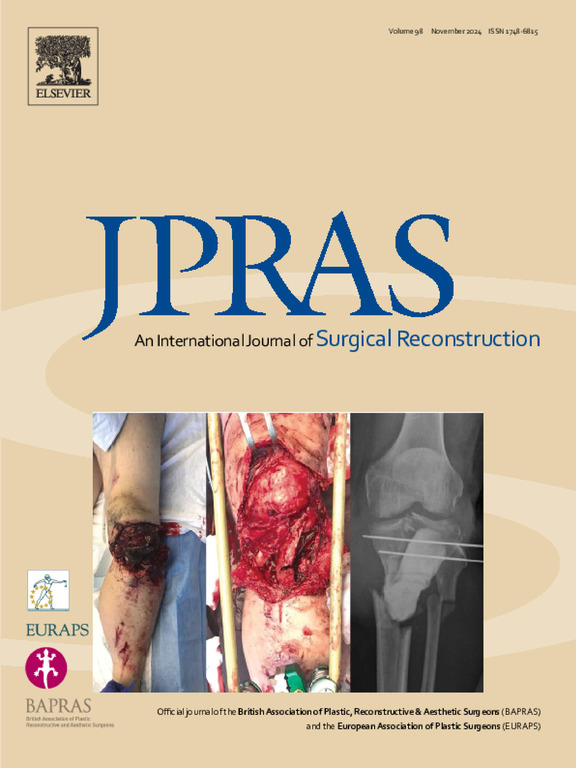年龄较大可能预示着积极的乳房重建患者的加速护理
IF 2.4
3区 医学
Q2 SURGERY
Journal of Plastic Reconstructive and Aesthetic Surgery
Pub Date : 2025-06-02
DOI:10.1016/j.bjps.2025.05.031
引用次数: 0
摘要
虽然不同年龄的乳房重建的结果和满意度相似,但老年患者的利用率较低。本研究考察了与年龄相关的护理时间表和手术时间的差异,以确定导致这种差异的因素。方法收集2017 - 2023年乳房再造患者的数据。结果包括指数和总手术时间,乳腺癌诊断和整形外科(PS)会诊之间的时间间隔,指数重建手术和最终重建手术。采用多变量回归分析绝对年龄和年龄四分位数介导的结果差异。结果1659例患者按年龄分为四分位数(Q): Q1(15.8 ~ 44.2岁,平均38岁,n=415), Q2(44.2 ~ 52.1岁,平均48岁;n=415), Q3(52.1-60.6,平均=56;n=416), Q4(60.6-85.4,平均=67;n = 413)。保险类型、重建方式和合并症负担在四分位数之间存在显著差异,后者在Q4患者中最高。多因素回归分析显示,随着年龄的增长,指数(β= - 0.002, P=0.019)和总手术时间(β= - 0.002, P=0.005)缩短。在临床时间线方面,年龄的增加预示着诊断和最终手术之间的时间间隔更短(β = - 0.006, p = 0.013)。此外,Q2患者(β = - 0.263, p = 0.046)和Q4患者(β = - 0.625, p = 0.021)与Q1患者相比,诊断和咨询PS的间隔时间更短。结论老年乳房再造术患者手术时间短,再造术完成速度快。这可能反映了在合适的候选人中更大的动机和更少的审美问题,或者是外科医生故意强调效率以减少麻醉暴露。本文章由计算机程序翻译,如有差异,请以英文原文为准。
Older age may predict expedited care for motivated breast reconstruction patients
Background
While outcomes and satisfaction with breast reconstruction are similar across ages, older patients have lower utilization rates. This study examines age-related differences in care timelines and surgery length to identify factors driving this disparity.
Methods
Data was collected on breast reconstruction patients from 2017 to 2023. Outcomes included index and aggregate procedure durations, as well as intervals between breast cancer diagnosis and Plastic Surgery (PS) consultation, index reconstructive procedure, and final reconstructive procedure. Multivariate regression was used to analyze both absolute age and age-quartile mediated differences in outcomes.
Results
1659 patients were divided into age-based quartiles (Q): Q1 (15.8–44.2 years, mean=38, n=415), Q2 (44.2–52.1, mean=48; n=415), Q3 (52.1–60.6, mean=56; n=416), and Q4 (60.6–85.4, mean=67; n=413). Insurance type, reconstruction modality and comorbidity burdens differed significantly between quartiles, with the latter highest among Q4 patients. Multivariate regression showed that increasing age predicted shorter index (β=−0.002, P=0.019) and aggregate (β=−0.002, P=0.005) procedure durations. Regarding clinical timelines, increasing age predicted shorter intervals between diagnosis and final operation (β = −0.006, p = 0.013). In addition, Q2 (β = −0.263, p = 0.046) and Q4 patients (β = −0.625, p = 0.021) showed shorter intervals between diagnosis and PS consult compared to Q1 patients.
Conclusion
Older patients undergoing breast reconstruction experience shorter operative durations and faster reconstruction completion than their younger counterparts. This may reflect greater motivation and fewer aesthetic concerns among suitable candidates, or a deliberate emphasis by surgeons on efficiency to minimize anesthesia exposure.
求助全文
通过发布文献求助,成功后即可免费获取论文全文。
去求助
来源期刊
CiteScore
3.10
自引率
11.10%
发文量
578
审稿时长
3.5 months
期刊介绍:
JPRAS An International Journal of Surgical Reconstruction is one of the world''s leading international journals, covering all the reconstructive and aesthetic aspects of plastic surgery.
The journal presents the latest surgical procedures with audit and outcome studies of new and established techniques in plastic surgery including: cleft lip and palate and other heads and neck surgery, hand surgery, lower limb trauma, burns, skin cancer, breast surgery and aesthetic surgery.

 求助内容:
求助内容: 应助结果提醒方式:
应助结果提醒方式:


